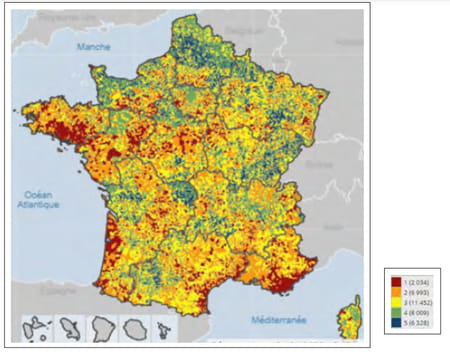These caterpillars can pose a risk to humans and animals. These maps reveal the affected localities.
If nature is full of surprises, they are not all pleasant. There are plants or animal species considered harmful and two types of caterpillars are therefore increasingly embarrassing in the environments where they exist. The oak processionary caterpillar and the pine processionary caterpillar are in fact two types of stinging caterpillars. Their silk or crying hairs can cause burns of different types.
As indicated on the websiteObservatory of processionary caterpillars, an official organism, the bristles of these caterpillars can be responsible for itchy rashes, conjunctivitis and respiratory irritation. These insects can also cause health problems in animals, particularly dogs and cats, which may suffer from inflammation of the mucous membranes, eye damage, excessive salivation and vomiting as well as irritation of the respiratory tract.
The Observatory also offers on its site maps listing all French departments having declared at least one case of processionary caterpillar between 2007 and 2022. For both species, most of the territory is affected. In detail, only 11 French departments escape the pine processionary moth. These are Pas-de-Calais, Somme, Seine-Maritime, Ardennes, Meurthe-et-Moselle, Moselle, Vosges, Haut-Rhin, Haute-Saône, the Territory of Belfort and the Doubs.
ANSES (National Agency for Health Safety, Food, Environment, Work) reports that “the areas presenting the highest level of risk are the Mediterranean arc (AURA, PACA, Occitanie), the Landes forest (coastal language ), part of the Center Val-de-Loire region and southern Brittany. Work was done to identify the presence of caterpillars by municipality, which can be found on this ANSES map.
For the oak processionary caterpillar, 16 departments do not record any cases of caterpillars. These departments are as follows: Charente-Maritime, Charente, Creuse, Corrèze, Cantal, Lozère, Ardèche, Vaucluse, Hautes-Alpes, Alpes-de-Haute-Provence, Alpes- Maritimes, Aude, Pyrénées-Orientales, Lot-et-Garonne, Tarn-et-Garonne and Corsica.
As the Observatory points out, the risk of contracting these problems is very high during periods of abundance of these species. This period is from January to April for the pine processionary caterpillar and from April to July for the oak processionary caterpillar, but it can vary depending on weather conditions. According to a report of ANSES in 2020, the poison control centers (CAP) recorded around 1,300 symptomatic cases of exposure to processionary caterpillars between 2012 and 2019. This figure could nevertheless be much higher because these are only cases declared.
The Observatory describes the pine processionary caterpillar as “a caterpillar a few millimeters to 40 mm long, blackish brown with reddish spots on the top and sides. Its ventral side is yellow.” While the oak processionary moth is “a few millimeters to 50 mm long, yellowish with a dark line on the back”. Both are also characterized by the silk hairs that cover them.
